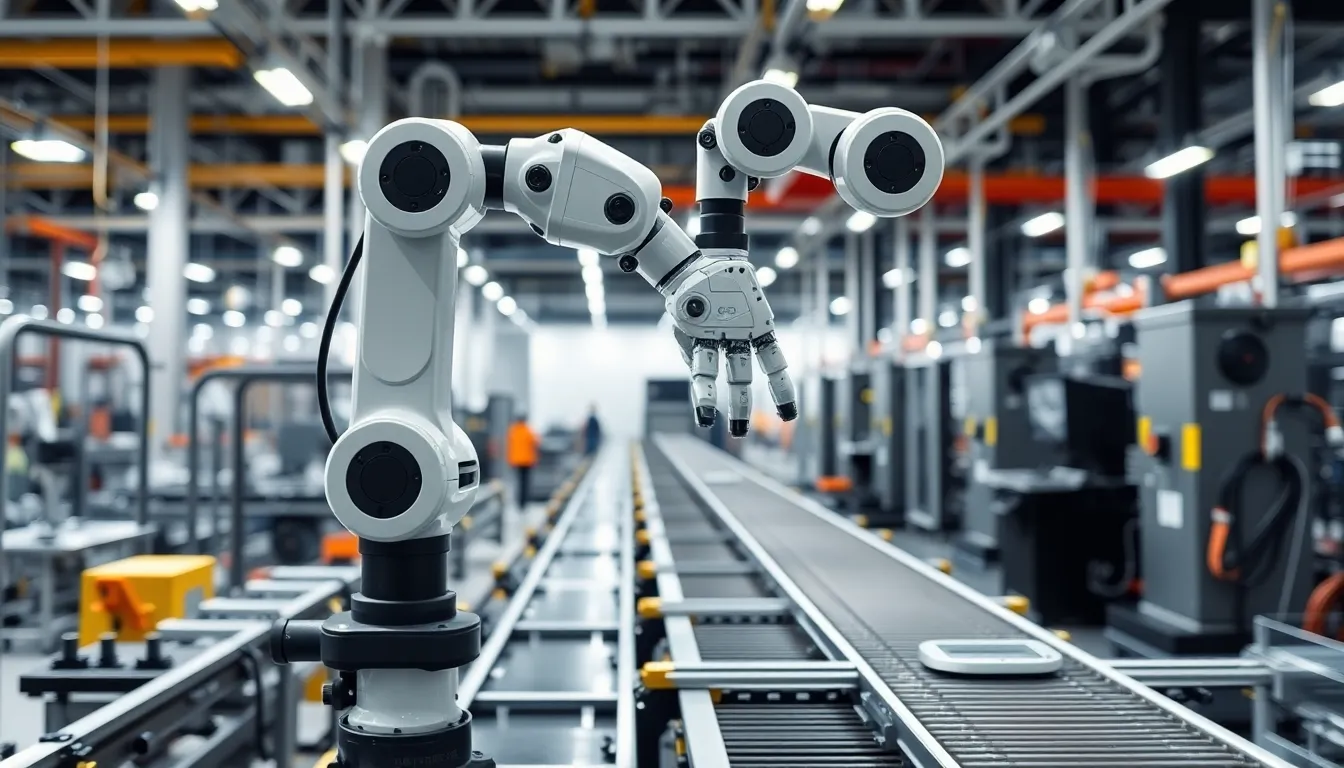Table of Contents
ToggleIn a world where even your toaster might have a Wi-Fi connection, automated systems in tech have become the unsung heroes of efficiency. Picture this: machines working tirelessly while humans kick back with coffee, blissfully unaware of the complex algorithms buzzing behind the scenes. It’s like having a personal assistant who never takes a lunch break—now that’s a dream come true!
Automated systems aren’t just about convenience; they’re revolutionizing industries, streamlining processes, and making life a whole lot easier. From smart homes that adjust the thermostat while you binge-watch your favorite series to AI-driven customer service that answers questions faster than you can say “robot takeover,” these systems are here to stay. So buckle up and get ready to explore the fascinating world of automation, where technology meets efficiency and a bit of humor.
Overview of Automated Systems in Tech
Automated systems play a crucial role in modern technology. These systems streamline operations across various industries, improving efficiency and reducing human error. In manufacturing, for instance, robotics and automation enhance production rates, allowing businesses to meet market demand swiftly.
Smart homes exemplify how automation simplifies everyday tasks. Devices like smart thermostats, lights, and security systems work together to create convenience and energy savings. Users can control these devices remotely, contributing to a seamless living experience.
Artificial intelligence (AI) further expands the capabilities of automated systems. With chatbots and virtual assistants, companies provide prompt customer service. These AI-driven tools analyze data to deliver personalized experiences, increasing satisfaction among users.
Healthcare is another sector experiencing significant transformations due to automation. Electronic health records (EHR) systems streamline patient information management. Automation in diagnostics allows for quicker and more accurate results, benefiting both healthcare providers and patients.
Emerging technologies, such as machine learning, enhance the adaptability of automated systems. As these systems learn from data, they improve their performance over time. This continuous evolution leads to smarter solutions in various applications.
Automation also reshapes workflows in finance with algorithms executing trades at high speeds. Financial institutions leverage automated systems to detect fraud, improving security and risk management.
The ongoing development of automated systems indicates a shift toward increased reliance on technology. As industries adapt, the benefits of efficiency and precision become more evident. Companies investing in these technologies find themselves better positioned for future challenges.
Types of Automated Systems

Automated systems can be categorized into software and hardware types, each serving distinct functions in various industries.
Software Automation
Software automation includes applications that execute tasks without human intervention. Robotic Process Automation (RPA) streamlines repetitive workflows by mimicking human actions in digital environments. Businesses leverage automation tools like CRM systems and marketing automation platforms to enhance productivity and customer engagement. For example, chatbots engage users in real-time, providing instant responses and support. Additionally, automated testing software ensures quality in application development by performing exhaustive tests on code with minimal manual effort. This focus on efficiency reduces operational costs and increases accuracy in software processes.
Hardware Automation
Hardware automation refers to physical devices designed to perform specific tasks autonomously. Robotics plays a vital role in manufacturing, as automated machines enhance precision and speed on assembly lines. Drones and autonomous vehicles further exemplify hardware automation through their ability to navigate environments without direct human control. Smart home devices, including thermostats and security cameras, automate everyday functions such as climate control and home monitoring. These advancements contribute to energy savings and improved safety, showcasing the impact of hardware automation on lifestyle and operational efficiency.
Benefits of Automated Systems in Tech
Automated systems significantly enhance various technological aspects. They promote notable advantages that boost both operational efficiency and financial performance.
Increased Efficiency
Automated systems streamline tasks, leading to faster completion times. Organizations experience improved output by eliminating manual processes. Machines handle repetitive tasks, allowing employees to focus on complex projects. For example, robotic assembly lines operate continuously, increasing production rates. In software, automation tools simplify processes, reducing the need for additional staff to manage workflows. Businesses that adopt these technologies often see a marked improvement in overall productivity.
Cost Reduction
Integrating automated systems leads to substantial cost savings. Companies save on labor costs by reducing the number of employees required for repetitive tasks. Automation minimizes human error, which often results in costly mistakes. For instance, algorithms used in finance can execute trades efficiently, lowering transaction fees. By consistently monitoring operations, businesses identify opportunities to cut unnecessary expenses. Enhanced efficiency often translates to reduced operational costs, allowing for better resource allocation.
Challenges in Implementing Automated Systems
Implementing automated systems presents several challenges that demand careful consideration. These obstacles can hinder the seamless integration of technology within various sectors.
Technical Barriers
Technical barriers often arise during the implementation of automated systems. Compatibility issues between new systems and existing technologies can lead to significant disruptions. Additionally, inadequate infrastructure may fail to support advanced automation tools, causing inefficiencies. Complexity in coding and maintaining these systems further complicates their deployment. Security concerns also play a crucial role; safeguarding automated systems from cyber threats is essential for operational integrity. Organizations must address data privacy regulations to ensure compliance. Lastly, organizations need to invest in ongoing maintenance and updates, which can add unforeseen costs to automation initiatives.
Workforce Impact
The impact of automation on the workforce generates significant discussion. Job displacement remains a primary concern for many employees, particularly in roles heavily reliant on manual tasks. Employees may experience fear of redundancy as machines assume responsibilities traditionally performed by humans. However, automation can also create opportunities for retraining and skill enhancement, allowing workers to transition into more strategic roles. Facilitating this transition requires effective change management strategies. Collaboration between employees and automated systems can lead to improved productivity and job satisfaction. Organizations must communicate the benefits of automation clearly to foster acceptance among staff members. Maintaining a skilled workforce ensures businesses can adapt to evolving technological landscapes.
Future Trends in Automated Systems
Automation continues to evolve rapidly, with several key trends shaping its future. Increased adoption of artificial intelligence enhances the capabilities of automated systems. Intelligent algorithms can analyze vast data sets, enabling smarter decision-making across various sectors. The Internet of Things (IoT) will see greater integration, connecting devices to streamline processes in smart homes and industries.
Another significant trend involves robotic process automation (RPA). It increasingly automates repetitive tasks across organizations, driving productivity and allowing employees to focus on strategic initiatives. Companies that implement RPA can experience substantial efficiency gains.
In healthcare, telemedicine platforms are on the rise. Automated systems facilitate remote monitoring, enhancing patient care by providing real-time data to medical professionals. These advancements improve healthcare delivery and support better patient outcomes.
Additionally, the financial sector is embracing automation more than ever. Algorithms optimize trading and fraud detection, minimizing risks and increasing transaction speeds. Financial institutions leverage these tools for enhanced security and efficiency.
Moreover, advancements in autonomous vehicles hold promise for transportation. The technology can revolutionize logistics, reducing costs while improving delivery times. These vehicles rely on automated systems to navigate safely and efficiently in urban environments.
Lastly, the importance of ethical considerations around automation is rising. As systems become more integrated into daily life, transparency and accountability in their operations will be crucial. Organizations must prioritize ethical guidelines to foster trust among users.
Overall, the future of automated systems points to greater efficiency and integration across industries. Continuous innovation and adherence to ethical standards will shape a world increasingly influenced by automation.
The evolution of automated systems in technology marks a significant shift in how industries operate and how individuals interact with their environments. As these systems become more advanced and integrated into daily life, their potential to enhance efficiency and convenience continues to grow.
While challenges exist in implementation and workforce adaptation, the benefits of automation are undeniable. Increased productivity cost savings and improved safety are just a few of the advantages driving this technological transformation.
Looking forward the future promises even greater advancements in automation fueled by artificial intelligence and IoT. Embracing these innovations responsibly will be crucial for organizations aiming to thrive in a rapidly changing landscape.




